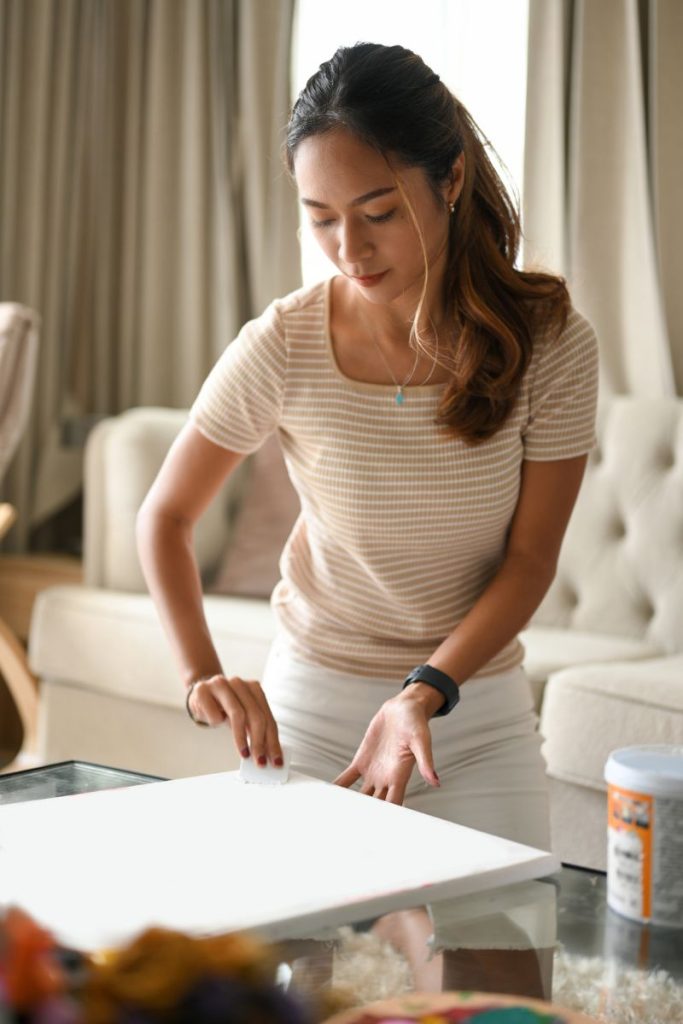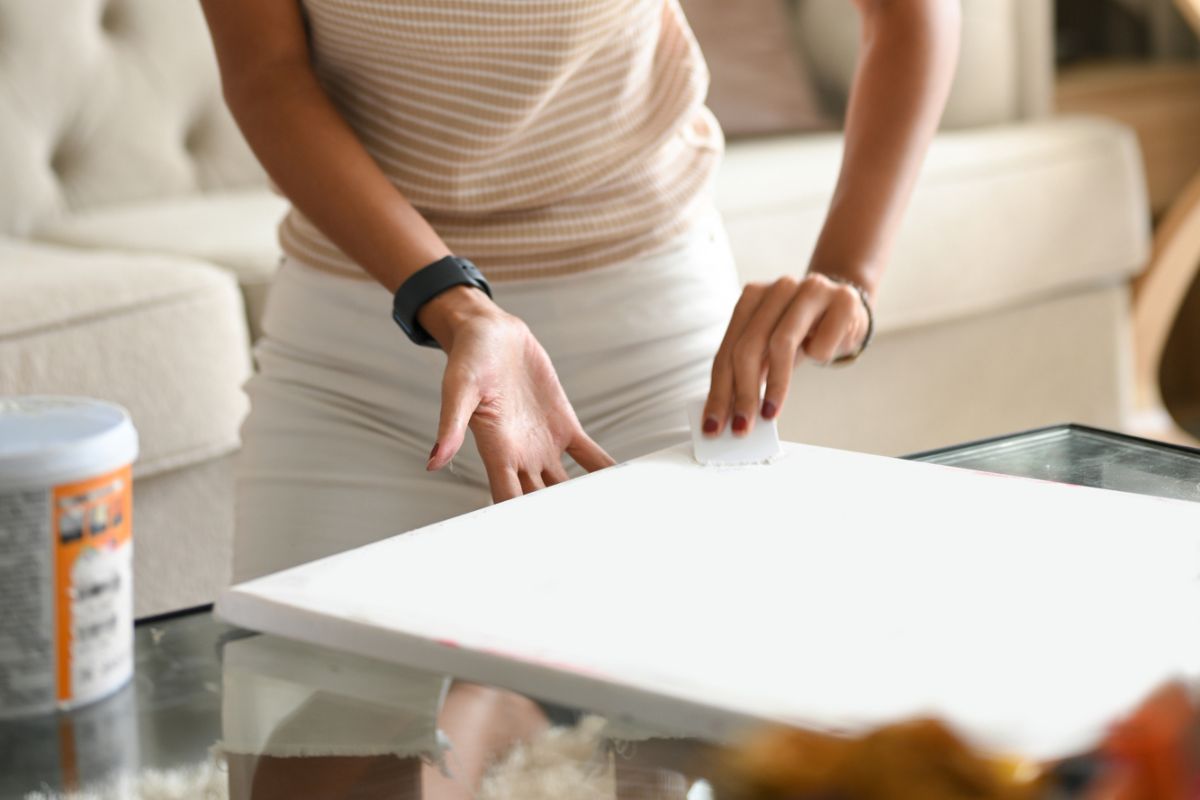When one first begins painting, a lot of mistakes are going to be made. One of the biggest mistakes is using a canvas that has not been primed before painting.
I understand that you want to start painting as soon as you buy a new canvas. But, it is important to make sure that canvas is primed if you want to have a painting that will look great and that will hold up for many years to come.
When it comes to prepping a canvas, there are a few stages to consider. Terms such as sizing, priming, and underpainting can be confusing, especially for beginners.
Today I am going to discuss how to properly prep a canvas for oil painting and before using acrylic paint, so it is ready to paint on. Read on to learn more.
What is Priming?
Priming a canvas means that you are getting it ready to paint on. Many people don’t realize that a canvas can rot over time if it has not been primed before painting.
Also, if you do not prime a canvas the paint colors could end up seeping through to the other side of the canvas. When a canvas is primed, the paint will sit better on the surface instead of seeping through.
Priming is particularly important if you are working with oil paints. When you prepare canvas for oil painting, it will make the colors pop, and there won’t be a lot of dull spaces in the final product.
Priming a canvas ensures that the surface will be even for painting. When you have that smooth surface, it makes it easier to use various brush strokes, because the brush will glide across the canvas.
How does a canvas primer work? As it dries, it stretches across the canvas. This makes the canvas tighter, allowing it to hold the color better and give that smooth surface (even if your painting will have texture).

What Do You Prime a Canvas With?
Whether you are using acrylic or oil paints, the best way to prime a canvas is by using gesso.
You can also use a solvent-based oil primer if you are working with oil paints, but you will need to size the canvas.
What is Gesso?
As a canvas primer, Gesso looks a lot like white paint. I have had many paint and sip students ask if they can simply use white paint instead of gesso. The answer is no, even though Gesso is a white paint mixture.
Gesso is made with a binder that is mixed with chalk, pigment, or gypsum. Sometimes it is made with all three. There is regular gesso, and then there is acrylic gesso, which gives you pretty much the same results.
You can also use clear gesso if you want the canvas to maintain its original appearance. I do not recommend using oils with acrylic gesso.
How to Apply Gesso to a Canvas
Gesso is applied with a paintbrush. I recommend using a wide, flat brush that has short bristles. Be firm while brushing the gesso onto the canvas, and cover the entire canvas.
Normally it takes about two coats of gesso to properly prepare a canvas. The first coat can be thinned with a bit of water so it goes on smoother. This will also allow it to soak into the canvas better.
When applying acrylic gesso, the method is pretty much the same as applying oil gesso after sizing a canvas. Apply the gesso in one direction, and make sure that there is enough gesso to sit on top of the canvas without seeping through. This will ensure that your paint also does not seep through later on.
Once the first coat of gesso is dry, you can apply a second coat. Again, make sure that you are brushing it on in one direction, and the same direction as the first coat. Allow the second coat to dry, and then if necessary, apply a final third coat, again, in the same direction.
How Long Does it Take for Gesso to Dry?
Unfortunately, it is going to be a day or two before your canvas is ready to use. Generally, it takes an hour or two for each coat of gesso to feel dry to the touch.
After priming the canvas, you should wait at least 24 hours before you begin painting. It could be more or less time, depending on the humidity and temperature in your painting area.
What is Sizing?
I have mentioned sizing a couple of times. This is basically how you seal the surface and create a barrier between the support, ground, and layers of paint.
When using sizing, it makes the support less absorbent. Sizing is important if you are doing an oil painting. If you do not take this step, the fibers of the support may soak up your paint, which will eventually cause it to rot.
When using an oil painting primer, it is important to use rabbit skin glue for sizing.
Are Sizing and Priming the Same?
Sizing and priming are not the same. Sizing is for oil paintings, and provides a smoother surface. Acrylic and thixotropic primers will provide a more textured surface.
Do You Need to Use Gesso?
Yes, you do need to use gesso to prime a canvas for acrylic painting. But, if you have used rabbit skin glue, you can use other types of primers.
Understanding Oil Painting Primer
If you are working with oil paints, instead of gesso you will need to use an oil painting primer. You can also use an oil-modified alkyd resin medium or a thixotropic medium.
Some oil painting primers are ready to use and do not need to be thinned or stirred. These primers are ideal for porous surfaces such as untreated wood and will prevent the paint from sinking into the surface.
You can also make tinted primer by mixing a bit of your paint into the primer, as long as the canvas has been sized first.
Using a Pre-Primed Canvas
I love buying pre-primed canvases. If you are anything like me, you want to dive right into painting as soon as you bring home a new canvas.
With a pre-primed canvas, all of the work is done for you. You can get pre-primed cotton and linen stretched canvases in a variety of sizes and shapes.
Another option is to buy a rolled cotton canvas that is already primed if you want to stretch your canvas. Make sure you have a pair of canvas pliers when stretching a cotton canvas.
You may also want to use canvas boards. These are great for anyone who is just starting with oils. They are just like a stretched or primed canvas, but the canvas is stuck to a hard backing.
Conclusion
If you don’t want to go through the hassle of priming a canvas before painting, I recommend buying pre-primed canvases. This will make it easy to jump right into painting without having to wait or do any extra work.
Whether you use a pre-primed canvas or gesso, it is important to prime every canvas you are going to paint on. You spend a lot of time, money, and effort to create your art, so you want to make sure that it is going to stand the test of time.
Check my guide on the best types of canvas paint for more tips.
See more:
*image by BongkarnGraphic/depositphotos
Sari Green is a semi-professional artist and professional writer. She has been hosting paint & sip parties for the past couple of years, and truly enjoys helping other people to create their very own masterpieces. She loves to create, and you never know what she’s going to come up with next!

